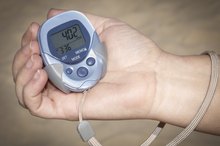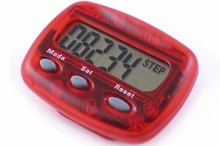What does fact checked mean?
At Healthfully, we strive to deliver objective content that is accurate and up-to-date. Our team periodically reviews articles in order to ensure content quality. The sources cited below consist of evidence from peer-reviewed journals, prominent medical organizations, academic associations, and government data.
- ACE: Fit Facts -- A Walk a Day
- MayoClinic.com: Exercise for Weight Loss: Calories Burned in 1 Hour
- Centers for Disease Control and Prevention: General Physical Activities De fined by Level of Intensity
- Harvard Men's Health Watch: Walking: Your Steps to Health
- PLoS One; Step-to-Step Variability in Treadmill Walking: Influence of Rhythmic Auditory Cueing; P. Terrier
- PLoS One; Step-to-Step Variability in Treadmill Walking: Influence of Rhythmic Auditory Cueing; P. Terrier
The information contained on this site is for informational purposes only, and should not be used as a substitute for the advice of a professional health care provider. Please check with the appropriate physician regarding health questions and concerns. Although we strive to deliver accurate and up-to-date information, no guarantee to that effect is made.
How Many Miles per Hour Does the Average Human Walk?
The average walking speed for humans is 3.13 mph, but your pace may be slower or faster than average, depending on your fitness level. Walking is an easy way to begin a fitness program. At first, you may walk at a slow pace, but as you begin to get in shape your miles per hour may increase relative to your walking style. To burn more calories, though, you'll have to pick up the pace.
Strolling
Whether you're walking for relaxation after a stressful day, warming up or cooling down after a brisk walk, or simply taking your time, the average walking speed when strolling is 2 mph. According to the Mayo Clinic, when walking at 2 mph, your body burns an average of 204 to 305 calories per hour, depending on your weight. In comparison, tai chi, bowling and ballroom dancing, which burn approximately 219 to 327 calories per hour.
Moderate to Brisk Walking
How to Determine Walking Speed
Learn More
The U.S. Centers for Disease Control and Prevention recommends a brisk 30-minute daily walk. A moderate to brisk pace is between 3 and 4.5 mph. At an average pace of 3.5 mph, you can burn between 314 and 469 calories per hour. While a brisk half hour walk may not be practical on a busy work day, dividing the walk into two 15 minute segments provides the same benefits without disrupting your day.
- The U.S. Centers for Disease Control and Prevention recommends a brisk 30-minute daily walk.
- At an average pace of 3.5 mph, you can burn between 314 and 469 calories per hour.
Race Walking
Race walking, also known as aerobic walking or power walking, requires a significantly faster pace than the average walk. At 5 or more mph, you are moving as quickly as a jogger. Race walking is considered a vigorous activity, burning more than 600 calories per hour -- equivalent to jogging or running at 5 mph.
Pick Up the Pace
Steps to Miles Conversion for a Pedometer
Learn More
When transitioning to a faster pace, music helps keep you on track. Rather than counting your steps per minute, use the beats per minute of your favorite tunes to keep yourself moving in rhythm. According to Harvard Men's Health Watch, 80 steps per minute is equivalent to strolling. Listening to an 80 BPM song, such as a waltz, contemporary neo-jazz or R&B slow jam, keeps your pace steady. A brisk walk is about 100 steps per minute, or 100 BPM, while race walking is 120 or more steps per minute. This pace is equivalent to the BPM of a polka, disco or techno song.
- When transitioning to a faster pace, music helps keep you on track.
- According to Harvard Men's Health Watch, 80 steps per minute is equivalent to strolling.
Related Articles
References
- Journal of Rehabilitation Research & Development; Electromyographic and Kinematic Nondisabled Gait Differences at Extremely Slow Overground and Treadmill Walking Speeds; Jennifer R. Nymark, MScA, BScPT, et al.
- ACE: Fit Facts -- A Walk a Day
- MayoClinic.com: Exercise for Weight Loss: Calories Burned in 1 Hour
- Centers for Disease Control and Prevention: General Physical Activities De fined by Level of Intensity
- Harvard Men's Health Watch: Walking: Your Steps to Health
- The University of New Mexico Exercise Science: The Effects of Music on Exerise?
- PLoS One; Step-to-Step Variability in Treadmill Walking: Influence of Rhythmic Auditory Cueing; P. Terrier
Resources
Writer Bio
With degrees in fine and commercial art and Spanish, Ruth de Jauregui is an old-school graphic artist, book designer and published author. De Jauregui authored 50 Fabulous Tomatoes for Your Garden, available as an ebook. She enthusiastically pursues creative and community interests, including gardening, home improvement and social issues.









